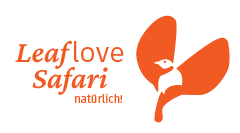Trip Report - Avifauna Namib-Zambezi 2023
- Home
- About us
- Travelogues
- Trip Report – Avifauna Namib-Zambezi 2023
a guided Birdingtour in November 2023
Travel report of a birdwatching trip with Birdingtours to Namibia, Botswana, Zimbabwe; Endemics, special birds like the Pel's Fishing Owl
conducted in a group size of 5 people
Trip Report – Avifauna Namib-Zambezi 2023
Agent: Birdingtours
Groundwork: Leaflovesafari
Guide: Albert Voigts von Schütz
At the airport, house sparrows diligently nested and chirped in the date palms as Dirk and I awaited our guests. Dirk, a seasoned patron of Birdingtours, had arrived a few days earlier. Despite the scorching heat, the group appeared in high spirits and brimming with energy. Our journey kicked off with a detour to Avis Dam, where the tranquil scene, teeming with Red-knobbed Coot, Red-billed Teal, and colourful Maccoa ducks, provided a serene introduction to the African heat.
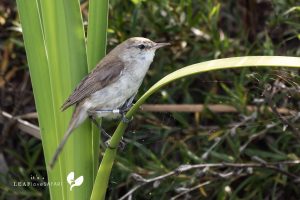
Lesser Swamp Warbler / Kaprohrsänger
In the reeds, the elusive Lesser Swamp Warbler responded to our calls, though remaining cleverly concealed. A brief sighting during a fleeting flight was all we managed. The distinctive call of the Rattling Cisticola echoed, and we observed the commonplace birds of the central high plateau on the dry floodplains, including the one and other various-sized African Pipit.
In the city, our Swiss companions, Ladina and Urs, procured malaria prophylaxis while others withdrew cash from ATMs and indulged in a bit of soulful shopping at the supermarket. “Are we circling the globe today, or where does this path lead?” It seemed Kerstin had her fill and longed for a final destination.
Upon reaching the Midgard Lodge, binoculars once again rose to the sky. The weariness of travel seemed to dissipate; after all, “we are not on vacation and want to witness something.” Inspired, I introduced the guests to the unique Damara Red-billed Hornbill and a ground-hunting Bennett’s Woodpecker, while the elusive Rüppell’s Parrot hid among the trees.
The Midgard Lodge, splendidly renovated, delighted all with its modern, spacious rooms and delectable, lavish meals. The competent waiter served long-awaited gin and tonics, beer, and the locally favoured Rock Shandy.
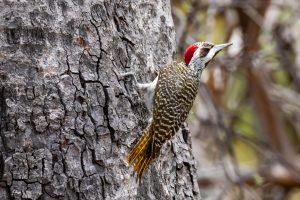
Bennett’s Woodpecker / Bennettspecht
Traversing the Khomas Highlands, I shared tales from the life of a farmer’s son, exploring meat production and the philosophy of “proper shopping instead of vegetarianism.” Yet, Ladina, a vegetarian, navigated her dietary choices gracefully.
It was an exhaustive day, climbing the Hausberg early amidst the arid landscape. Unfortunately, the endeavour proved dry and fruitless, it was to hot and dry, no reason for birds to stay here no more. The search continued through Monte Christo’s dams and dry forests, seemingly endless as we embarked on the long drive into the Namib Desert.
Amongst Monte Christo’s towering winter thorn and camel thorn trees, the vibrant observation of a Violet Wood Hoopoe group proved both delightful and frustrating. While these birds noisily paraded past us, they refused to pose perfectly for photographs. A pearl-spotted owlet graciously visited, providing a serendipitous photographic opportunity.
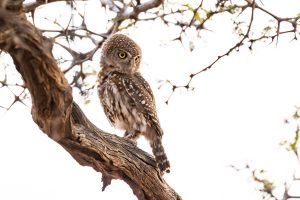
Pearl-spotted Owlet / Zwergperlkauz
The dams hosted discussions on non-breeding Ruff, could they all be Reeves?, distinguishing Intermediate, Great and Little Egret, and the amusing mating antics of Kittlitz’s plover, who feign death on their backs post-copulation. A Jacobin Cuckoo sparked excitement, its impressive call resonating.
Amidst this avian spectacle, Greater kudu, Blue Wildebeest, Giraffe, and a small group of Waterbuck offered a welcome diversion.
As we reached the western edge of the Spreedtshoogte Pass, the earth seemed to vanish beneath us. I intentionally chose this breathtaking detour for the panoramic view of the Namib Desert spanning hundreds of kilometres. Descending steeply, we arrived at the Rostock Ritz Lodge just before sunset.
En route, we marvelled at the colossal nests of Sociable Weavers and revelled in the resonant calls of Rüppell’s Korhaan.
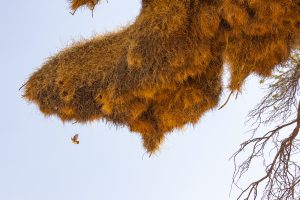
Sociable Weaver / Siedelweber
An early start saw us venturing into the dunes, with the gracious permission of Hein from the Rostock Ritz Lodge. Concerns over the absence of Dune Lark tracks dissipated as I discovered Dune Ants—the lark’s prey. The melodic call of this unique endemic bird echoed in the distance, and a bit audaciously, I whistled for the group. The Dune Lark presented itself splendidly, singing its distinctive song, leaving the group enthralled not only by the bird but also by the mesmerizing landscape.
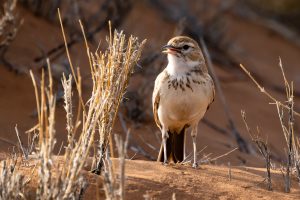
Dune Lark / Dünenlerche
Our journey continued through the Gaub Canyon, the Kuiseb Canyon, until we reached the gravel plains of the Namib. Vast expanses stretched before us until we arrived at the granite landscape of the Tinkas Plain. The relentless heat felt like a penance as we ventured into the scorching sun for birdwatching, yet a Bokmakierie perched on a granite rock and a particularly beautiful Black-chested Prinia seemed even more charming in this setting.
Several stops later, determined not to abandon the search for the rare Karoo Eremomela, we found the right habitat amidst Damara Euphorbias and red-barked Acacias. This time, attempting alone, I discovered the elusive bird. The group swiftly gathered, forgetting about the heat for a minute whilst checking out this rare species, allowing us to gratefully continue our journey.
At Blutkopje, we marvelled at the beautiful Quiver Trees and the picturesque granite massif adorned with gigantic Euphorbias, inaccurately referred to as Candelabra Euphorbias.
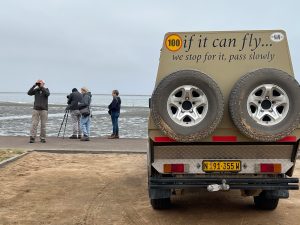
Leaflove Safari – if it can fly, we stop for it!
Swakopmund welcomed us with some free time, which most in the group filled with private „garden-birding” to find the Orange River White-eye and other city specials like the very Common Waxbill. In the evening, we gathered at the Jetty Restaurant, where Cape Cormorants behind the glass front provided a unique dining backdrop. Dirk and I savored fresh oysters, while others opted for a more refined meal, enjoying good Sole.
Navigating the thick beach sand in the 4×4, we explored Red Knot and Co., observing Sanderlings, African Oystercatchers, and a great variety of other common waders. Our journey continued to the 11,000-hectare lagoon, teeming with thousands of Greater and Lesser Flamingo. Binoculars, however, frequently turned to the inconspicuous waders, thousands of which graced the scene. The large Eurasian Curlew captivated me, since we hardly ever see those these days, while the group delighted in Damara Terns, White-fronted and Chestnut-banded Plovers. Today, their enthusiasm peaked with Black- and White-winged Terns among the myriad other tern species.
In conclusion, I led the group to the bird paradise, where thousands of Flamingos against the backdrop of beautiful dunes left them enthralled. Urs discovered an African Gallinule in the reeds and shared an impressive observation he had of a Baird’s Sandpiper he went for in Switzerland. We observed some Common Reed Warbler and then made our way back. An early breakfast preceded our departure to Spitzkoppe.
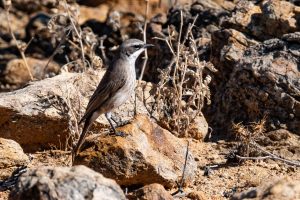
Herero Chat / Namibschnäpper
On the outskirts, I sought the ideal habitat of the Herero Chat, and we traversed the rocky terrain, once again enduring the heat, yet no one complained. A brief rendition of the Herero Chat’s call yielded a grateful response from the seemingly barren surroundings. The Herero Chat, though well-camouflaged in the landscape, was eventually spotted, and everyone not only saw but also photographed this extremely rare and elusive Namibian bird—a birding euphoria, as I see it.
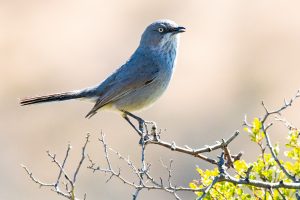
Layard’s Warbler or Tit-Babbler
We ventured further into Spitzkoppe and encountered remarkable birds such as Layard’s Tit-babbler or Warbler, Common Scimitarbill, White-tailed Shrike, Monteiro’s Hornbill, and surprisingly, another Herero Chat! The rocks seemed to engulf us, and everyone was captivated by this fantastic landscape. Thick, gnarled stems, this vine is known locally as Butter Trees, adorned the steep slopes, and at lunchtime, Pale-winged Starlings paid us a visit.
I showcased a bit of touristy charm by presenting the Granitic Arch or Rock Arch. Sabine, apparently not accustomed to seeing other tourists, as we value individualism, expressed her disdain in a true northern German way. Got to know those to love them while they make no secret of how they feel… Some other tourists jumped into her intended photographic „frame“ and “simply wouldn’t leave.” … oh dear.
The afternoon offered free birding time for all, and we braved the scorching air at Omandumba, a rustic yet distinctly southwest-typical bush camp. The group felt visibly at ease here, undoubtedly due to the personal welcome from the owner, Deike Diekman.
White-throated Canary could be compared to Black-throated Canary, the Great Sparrow, affectionately called Rusty Sparrow in German, displayed its rust-coloured attire, and Red-faced Mousebird gracefully navigated through a quaint Caper Bush (specifically referring to Boscia foetida, which attracts common houseflies with its pungent flowers).
The White-faced Scops Owl called me out of bed early, but I wasn’t quick enough to locate it. We witnessed a beautiful sunrise, painting the granite in a reddish glow, as we called the first Rockrunners and were quickly rewarded with good sightings and a small concert by these wonderful rock dwellers.
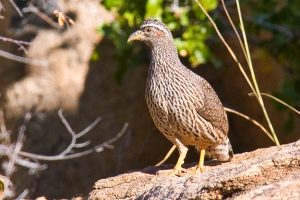
Hartlaub’s Spurfolw / Hartlaubfrankolin
I had previously spotted four families of Hartlaub’s Francolin in this area on other trips, but today was surprisingly quiet. However, the boisterous calls of Chacma Baboons echoed through the air. The Hartlaub’s Francolin sighting is a must for any birding tour, making it a Namibian special, so I was terribly nervous not being ale to find it due to the drought and heat.
We also observed some Scrub Hare, Lepus saxadilis, and Kerstin and Sabine were still enchanted by the morning Springhare sighting, which is considered a rodent. Later, we caught a glimpse of the Bushveld Sengi, more of a predator than a mouse and explicitly not classified as a rodent!
On the arrival day, the owner, Harald Rust, had informed me where he often encounters the Francolin near his scrapyard on the hill. This was my last hope, and we all headed towards the small inconspicuous hill. As soon as we got out of the car, a small bird darted into a Paperbark Acacia—it was indeed a Willow Warbler, a “great find” for us in Namibia, although the group was not quite as enthusiastic. We climbed up the hill; no Francolin. I played its call repeatedly, but silence prevailed. Out of desperation, I played the call of the Pearl-spotted Owlet again to attract some list-fillers. A Pritit Batis here, a Yellow-bellied Eremomela there, and suddenly, in the distance, the call of the Hartlaub’s Francolin. I almost ran, let’s go! After about 50 meters, the Francolin explosively took off in front of me and landed, not too far away, on an open rock. I could lure them a bit, and they reacted fantastically. The birds presented themselves, calling and clearly visible—it was fantastic, there were four of them, and we were all happy, needless to say how incredibly relieved I was. As we were getting into the car, all already inside, I saw the Long-billed Crombec, so everyone out again—not particularly appealing in the heat, but birding is not a vacation and I wanted the group to see the different subspecies of birds, even the common ones, throughout the trip.
After checking out, we visited Didi, my friend, on the Erongo Rocks farm. Here, an Ovambo Sparrowhawk flew through the ancestor tree—thanks to Kerstin, who apparently could spot things faster than the rest of us, for the sighting. On the way, we already saw a few Giraffes, but Terry, Didi’s wife, mentioned that we had just missed a large herd of Giraffes drinking in front of their house. We continued into the rocky terrain past Yoga Rock.
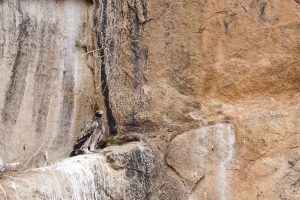
Verreaux’s Eagle Juvenile / Klippenadler Jungvogel
On the north slope, we saw the sought-after Verreaux’s Eagle nest and observed the beautifully contrasted fledgling. It was from this year and about three months old. We stayed here for quite a long time, waiting for the two adult Verreaux’s Eagles / Black Eagles. Carp’s Black Tit, another Namibian special, a Southern Fiscal, and a few Yellow-bellied Eremomela kept us company.
Although Ai Aiba Lodge is beautiful, other tourists are present, and as I explained, this lodge represents the new touristy Namibia, while Omandumba Bushcamp remains our old Southwest. In the afternoon, while self-drivers and others flaunted their visibly luxurious bodies by the pool, we embarked on a search. The Dassierat, Petromus typicus, wanted to be seen, but instead, we encountered several Black Mongoose again. A pair of Rock Kestrel attacked a Speckled Pigeon; Kerstin wasn’t too keen on “climbing that hill again,” and, as luck has it sometimes, another Damara Rockrunner appeared. We discussed climbing figs and purple podded Terminalias, witnessed the Long-billed Crombec attacking a Pearl-spotted Owlet, and marvelled as three Klipspringers adorned the granite walls in dizzying heights.
Today was a travel day to Etosha. We briefly checked in at the Etosha Safari Camp and headed into the park. Unfortunately, the park is extremely dry, and I struggled to find the usual birds this time. Of course, we were well served with Northern Black Korhaan and Kori Bustard; some Sabota, Starks, Spike-heeled, and Red-capped Lark showed themselves up close and were easy to photograph. At the Okaukuejo waterhole, a few waders were present. Here, by the way, an Elephant also appeared to the delight of the observers.
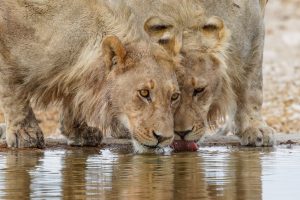
Panthera leo
At Gemsbokvlakte waterhole, lions came to drink right in front of us and then leisurely lounged around—impressive! Kerstin then bought a nice hat, unfortunately disfigured with the lodge’s logo. So, Kerstin had to endure my mockery and groaning.
Since Okaukuejo is the center of the national park, there are no smaller intimate accommodations either inside or outside the park. However, all are geared towards a lot of tourism, and that doesn’t suit everyone. Tomorrow should be better when we spend two nights at the naturally beautiful and still elegant Mushara Bushcamp.
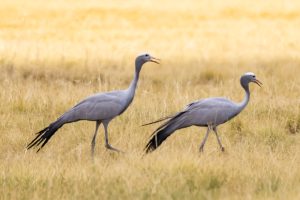
Blue Crane / Paradieskranich
A long day in Etosha. The Blue Cranes were the highlight according to Urs and Kerstin; personally, I found the Golden-breasted Bunting, although they are common, fantastic. Four of them with fanned tails and bright white outer feathers made a beautiful landing in the next bush. In the garden of Halali, watering was done around noon, and numerous birds, all clearly heat-beaten and panting, refreshed themselves in the lively greenery. Here, we saw Golden-tailed Woodpecker, Violet Wood Hoopoe, Southern Yellow-billed Hornbill, African Grey Hornbill, White-crowned Shrike, numerous Cape Starlings, some Icterine Warbler and some wonderful Willow Warblers. In the afternoon, Urs pointed out two more Wattled Cranes, and Kerstin spotted the Leopard first—having such top spotters in the car is fantastic. Under a tall Camelthorn tree at the Charitsaub spring, a pride of lions lay lazily around, and five Red-necked Falcons rested in the tree. Many Giraffes, a Spotted Hyena, and hundreds of Zebras appeared in the afternoon light; it was magnificent. Just before returning to camp, three Elephant Bulls strolled alongside us, and we enjoyed a small herd of Eland with calves and two Common Duiker, also called Bushduiker, an antelope that, believe it or not, does eat meat occasionally!
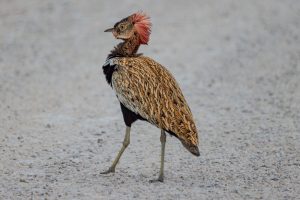
Red Crested Korhaan / Rotschopftrappe
Some days are simply magnificent, and today was one of them! The light of the early morning, interspersed with thick clouds and light rain, created a peaceful atmosphere. After a delicious breakfast alone in the garden of the Mushara Lodge, we could already observe colourful birds like Paradise Flycatcher, Golden Bunting, Red-billed Buffalo Weaver, and the Emerald-spotted Wood-Dove.
Various Sandgrouse delighted the group with their “morning drink” at Klein Okevi, and on the small Serengeti, the Andoni Plain, we witnessed an impressive gathering of Wildebeests and Zebras. At the edge of the wetlands, we saw numerous Chestnut-banded Plover and many wonderful waders. The absolute highlight was a group of Blue Crane, and then Urs spotted them first—the Caspian Plovers. Fantastic! There were only seven of them, but at the northern waterhole, we saw another three, and for Sabine, it was a lifer bird—Hurray! Sabine was visibly delighted with the sightings and expressed her gratitude with a heartfelt fist kiss when we also got her desired bird, the Secretarybird, through the binoculars.
Pink-billed Lark and Eastern Clapper Lark were seen at our “secret” birding spot. Kerstin definitely has an eagle eye because she immediately spotted two Rhinos in the distance—two Black Rhinos, mother with calf, dehorned. This was followed by the usual discussion about the legalisation of the Rhino trade. First, I explained and showed a nest of the Cape Penduline Tit, which I later managed to locate—super! Things got really exciting when a Red-crested Korhaan “cracked” after its loud whistle. I knew she was now raising her red crest, but I wasn’t exactly sure where in the bushes she was. Suddenly, she walked out from behind the car, and I demanded an immediate “Raise the roof and look out the back.” The Korhaan presented itself fantastically behind our vehicle—something rare to witness indeed!
The light was rarely fantastic today. Giraffes on the vast grassy plain, dwarfed by gigantic cloud towers, Zebras in the golden, diffuse sunlight on golden-yellow grass—even the already rare and beautiful flowers of Rhigozium trichoconum seemed brightly yellow along the roadside. A Lion and gigantic Elephant Bulls right by the car concluded the day—simply magnificent.
In the Boma of the Mushara Bush Camp, there was an open-air dinner with Beef, Springbok, or Chicken. We tried everything, and as always, the food was excellent—so was the service.
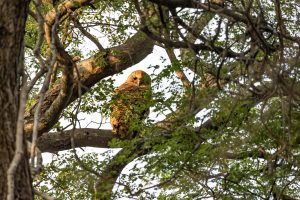
Scotopelia peli – named after H.S.Pel governor of Gold Coast (Ghana)
The journey between Mushara and Drotsky in Botswana was long, very long. In the rearview mirror, I saw open, sleeping mouths and dreamy looks on the quickly passing, monotonous dry forest. Early in the morning, a Pale Flycatcher greeted us. In between, slowing down, we could still observe a group of Black-faced Babbler, but life only seemed to filter back into everybody as we reached the Okavango.. The border crossing was calm and problem-free, without stress.
Upon reaching Drotsky, everyone was eager for a boat trip. However, a sudden rainstorm led us back to the lodge, where we enjoyed Rock Shandy and Gin Tonic.
At 6:00 a.m., we gathered, and the loud hooting of the Narina Trogon lured us into the delightful, untouched giant tree landscape, vehemently protected by the owner of the Drotsky Cabins. I must admit that I am not good at recognizing birds in dark forests, but Lukas, a gardener, helped me with a quick point, and we managed to spot the Narina Trogon. It was lucky to have this fantastic bird in the binoculars again. After breakfast, we headed onto the boat for systematic birding along the reed, papyrus, and bulrush-covered shoreline. Otto, an excellent local guide, not only showed us Giant Kingfisher, various Bee-eaters, and Hammerkop, as well as numerous waders, but also skilfully approached the birds correctly—no easy feat against the current of the Okavango.
The ornithological highlight was imminent! Never before have I seen this fantastic fish predator so beautifully, easily, and closely, even though I have chased after this owl countless times. The Pel’s Fishing Owl is not without reason one of the most sought-after and beloved birds ever!

Egretta vinaceigula, = wine coloured throat
We had a free afternoon, and another boat trip was planned for the afternoon. However, Petrus, the weather god, quickly thwarted our plans. It thundered and poured. In the evening, the impressive termite air show started. We watched the Southern Lesser Galago emerge from their hideouts and dart and jump through the trees without any fear of us. By the way, these animals belong to the primates. I heard a Barred Owlet in the distance, and we followed this sound as well as the calls of some Fiery-necked Nightjars. The little owl remained hidden, but the Nightjars flew over us and were active in hunting for flying insects. Since soon millions of termites would be flying out, I knew today was Christmas in Africa, and all termite eaters, whether fish, bird, mammal, or insect, would be well-fed and content today. After dinner, wonderfully tasting Lamb and Fish, Otto picked us up with the boat, and we drove downstream to a landing site frequented by owls. Here, we tramped loudly with calls from my speaker and flashlights through the tall forest. The African Wood Owl, formerly known as Woodford’s Owl, finally responded, and we could enjoy two brief sightings. Meanwhile, many termites were floating in the water, and various fish species, mainly Spotted Squeaker and catfish, were abundant on the water surface—visibly satiated. It was an impressive sight, seeing the water surface steam and near the lamps, these hundredfold green fish bodies lazily swim through the water and snatch termites. Now it was time to “make a list,” and indeed, many species were added today. It’s just fun to discover, identify, and discuss new species—a feeling of success and joy.
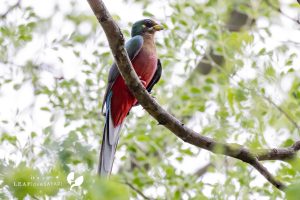
Narina Trogon / Narinatrogon
The next morning, only Sabine, Dirk, and Urs seemed to appear for the “Early Morning Walk.” The mood was already slightly subdued, and it was palpable that energy was waning. After scrutinising some feathered friends, we decided on a leisurely breakfast.
On the way through the dry forest, we could admire the impressive Broad-billed Rollers with a small detour, scold an invasive Myna, and discover some new species such as the Mosque Swallow. The border crossing went smoothly, and we continued our journey through the Bwabwata Park, where we even encountered Elephants.
The floodplains of the Okavango offered a view of numerous Red Lechwe Antelopes, some Buffaloes, a few Chapman’s Zebras, Impalas, and a variety of water birds. Urs focused the spotting scope on the Rufous-bellied Heron, an increasingly rare species. The Wattled Crane, of which we saw six individuals, is also becoming rarer. Briefly, we talked about the Intermediate Egret and added some “tiny birds high up in the trees” to the list, such as the Yellow White-eye and another Willow Warbler, a Black-headed Oriole and the Southern Black Tit were also nice to see and observe.
The Mahango Lodge left a positive impression. The garden was well populated by Meyer’s Parrots, and the Black Cuckoo constantly called its plaintive “it will raaaain” through the dense, tall garden tree landscape. In the evening, another boat trip followed with many familiar species. As a special highlight, the Rock Pratincole joined, and we had an excellent sighting of a Coppery-tailed Coucal. The White-backed Night-Heron, an otherwise hard-to-find species, seemed surprisingly easy to spot on this trip. On the riverbanks, Carmine Bee-eaters fed their chicks, while some Nile Monitors lurked above and below the nests to plunder them. Thousands of Spur-winged Geese, a group of Hippos, and a bowl of chips… the latter caused a humorous moment. The filled bowl was placed on a table just out of reach, so you had to stand up to get it. The ladies were convinced that this was a kind of “punishment” for the tourists—great laughter!
Half an hour longer this morning… I regretted this late rise, when the Levaillant’s Cuckoo woke me up, as I wanted to show it to the group. At breakfast, he reappeared, and all was well. The drive to Katima Mulilo, affectionately dubbed “Katima Trashilo” by Urs because of the garbage on the outskirts, went smoothly and was interrupted by two significant stops.
Stop 1 was a natural picnic spot where we found the Green-capped Eremomela. It delighted me to see this rare bird again.
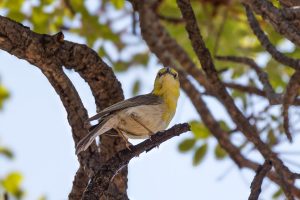
Eremomela scotops, = dark eyes, a misnomer
The Klaas’s Cuckoo responded kindly to my call and sat perfectly in front of us! Initially, we spotted a far off calling Yellow-throated Bush Sparrow, which I could only correctly identify later after taking a photo. Here, a familiar ‘Bird Guide Dementia’ crept in, and I had to later laugh at myself… well, that should work better next time!
Since I didn’t find the Racket-tailed Roller at a few roadside habitats, we had to penetrate deeper into the Bwabwata Park. Kerstin, Sabine, and Urs took care of the entrance, and off we went through the thick sand. I could find the Racket-tailed Roller at my “Secret Spot,” and we came across a herd of Sable Antelopes—not bad.
At the Caprivi River Lodge, incidentally a paradise for birdwatchers and anglers, Travis Langley welcomed us with plenty of birding info. While Travis himself is a keen birder, he promptly showed us where not only the Red-billed Firefinch but also its counterpart Jameson’s Firefinch could be found. After a coffee break and a Rock Shandy, we explored the surrounding wetlands and were thrilled by Lesser Jacana, Pygmy Goose, and some Whiskered Terns in breeding plumage. A short walk provided splendid views of Yellow-breasted Apalis and Orange-breasted Bush Shrike. Travis led the group back on foot, while I drove the car back. Dirk accompanied me, which was good since, as he always says, we “get along.” Dirk is now on this trip for the second time… what greater compliment can there be for a guide!
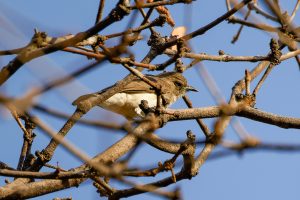
Prodotiscus regulus, = little king
Travis, of course, returned with a catch… the group had „bagged“an African Goshawk… fantastic! On the Zambezi, we treated ourselves to one or two beers and celebrated this wonderful time of day and the colourful atmosphere. Personal stories were told, and everyone seemed visibly happy. The chef of the Caprivi River Lodge is a true gem who prepares everything herself. Dinner was excellent, the meat tender, and the soup delicious.
During the Early Morning Walk, the Yellow-throated Leaflove soon made itself noticeable with its short “check” call. I played the call briefly, and soon, though quite high in the trees, they were wonderfully visible. We also searched for the Eastern Nicator, which, although heard, only briefly allowed us to “presume” its quick flyover. This was not enough for the participants of this birding tour, who by now expressed their dissatisfaction easily. Fortunately, an unexpected sighting of the Brown-backed Honeybird made up for it.
Touristically, the truly magnificent Schalow’s Turaco showed itself obediently. Its green body with bright red wings simply delights everyone, even if you’re not a bird enthusiast; it’s great for the average person too.
Hardly at the lodge, we took a short boat spray down the Namwi Channel since Travis, the owner of the Caprivi River Lodge, knew the roost of a European Nightjar. It was wonderful; on the way, we first saw the rare Lesser Jacana and were then entertained by a loudly trumpeting Trumpeter Hornbill flying over us. The European Nightjar sat in exactly the same spot as always, and we could even photograph it well. After a hearty breakfast, on Travis’s recommendation, we drove to a well hidden part of the Chobe Floodplain. Snipe search and found!
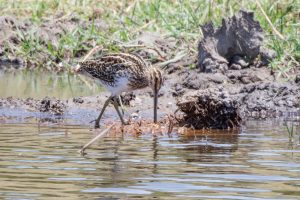
Gallinago nigripennis, = black-winged
The African Snipe is the absolute highlight. The snipe showed off feeding, „check out how far I can go down in the mud with my immensely long bill“… even putting its head underwater. We saw hundreds of Openbill Stork, correctly only referred to as African Openbill, Yellow-billed Stork, Spur-winged Goose, and many waders, most of them as usual Ruff, not to forget the Woolly-necked Stork.
Around noon, another border crossing in sweltering heat. Along the way, a group of Southern Ground Hornbill and a close view of a Kurrichane Thrush. We had to immigrate back into Namibia on Impalila Island, which had a birding advantage for us. Peter took us past the Chobe Rapids and, as Kerstin has great eyes, she spotted two Rock Pratincole chicks begging their mother or father for food on the rocks—so cute.
Here on the Chobe, thousands of birds fill the sky, the banks, the floodplains, the trees, and providing a detailed account would go beyond the scope of this narrative. In short, there is scarcely a moment when some form of wildlife doesn’t captivate our binoculars.
A boat safari offers a remarkably relaxing experience with an encompassing view of nature—a perfect way to observe birds. Unfortunately, the scorching heat left everyone breathless. The Zovu Elephant Lodge, while excellent, lacked air conditioning, making for a hot and humid night. Nonetheless, dinner was delightful!
“Inslaap,” as the Afrikaner describes it, involves a somewhat extended sleep to allow guests to unwind. I was scolded wanting to rise early and had to subdue my planning. Nonetheless, having risen long before sunrise, I phoned the lodge owner to make some coffee. Since we are friends, this was no issue; Peter and I share many moments in history and he wasn’t all to pissed off for waking him up for to long.
During the boat trip after breakfast, we initially passed by shorebirds, seeking and finding the Black-winged Pratincole, since hundreds of Collared Pratincole already nested on our list. To our delight, a Half-collared Kingfisher made an appearance—an incredible sight!
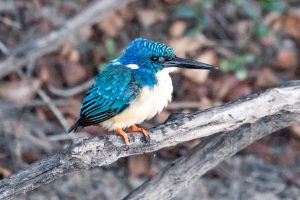
Half Collared Kingfisher / Kobalteisvogel
Our journey continued into the western part, where hundreds of elephants grazed on shallow islands.
The elephants are accustomed to daily tourism, and traditionally, the boats anchor in close proximity to the pachyderms. Kerstin, considerate toward the animals, was appalled at the idea of encroaching on the elephants’ space. The situation is indeed less obtrusive than it appears, but I would have gladly undone everything and arranged it according to my guests’ preferences. However, we’ll ensure to address this more thoughtfully in the future!
We encountered numerous elephants, hippos, and the relatively rare Puku antelope. An ornithological highlight was quite a number the Black-winged Pratincole, but the Yellow Wagtail was equally impressive, even though all Europeans on the trip have these „in their back yard“. After spotting the rare Slaty Egret once again, our joy multiplied when we repeatedly saw the African Snipe.
At noon, we relished delicious traditional meatballs, prepared according to the late matriarch Alta Visagie’s delightful recipe. I jokingly told the cook, Melody, that I looked forward to leaving to avoid gaining excess weight here.

Victoria Falls
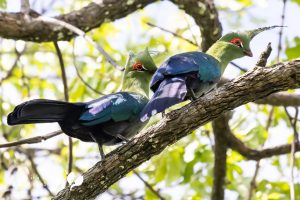
Schalow’s Turaco / Schalowturako
The drive to Vic Falls proceeded smoothly, thanks to our reliable contact at the border who efficiently handled visas, forms, taxes, and permits for transporting clients within Zimbabwe—for a small fee which was not all to small to be honest. Although this process is typically time-consuming and cumbersome, but „its who you know, not what you know“, as the saying goes, proved valuable.
As always, Vic Falls left a lasting impression, and I relished the amazed, satisfied expressions of my guests as they beheld the majestic waterfall. Bird observations remained a priority, and the sought-after Bearded Scrub Robin was soon spotted. Above us, a Hooded Vulture circled, while Neddicky and Grey-backed Camaroptera flitted alongside Blue Waxbills in the undergrowth. The White-browed Robin-Chat sang loudly and almost obtrusively, formerly known as Heuglin’s Robin, well within reach. After a delightful cappuccino at the Vic Falls Cafe, I keenly felt the yearning for home and regretted bidding farewell to these wonderful people. Nonetheless, I looked forward to reuniting with my wife and children. Regrettably, our group disbanded on the final evening, a couple wanted to enjoy a romantic dinner for two, diminishing the celebration of a successful trip. Dirk however generously treated us to dinner at the renowned Lookout Cafe, where Crocodile, Ostrich, and Pork were savored against the stunning backdrop of the Batoka Gorge. As rain approached and poured down, I marvelled at the wonders, colours and energy laden skies of Africa, grateful for the life I lead on this stunning continent.
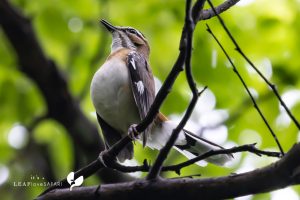
Bearded Scub-Robin
I would leave early the next morning, leaving my colleagues to handle the guests’ airport transfer.
But what if something fascinating crosses their path? Who will follow, explain and identify it?Then, by all means, next time—gladly.
Postscript: True to form, on my way back home, a Red-chested Cuckoo called during a short break right above me, a Black Kite narrowly avoided being run over, a Bradfield’s Hornbill appeared by the roadside, and indeed, the Dark-Chanting Goshawk perched boldly and prominently on a tall Kiaat, then flew meaningfully into the dry forest, as if saying: “You can’t have your cake and eat it too.”
Conclusion: This was undeniably one of the most challenging birding trips I have ever led due to extreme heat and exceptionally dry conditions. Many typically “easy and straightforward” species required significant effort, and some everyday birds remained elusive or absent altogether.
Nevertheless, we encountered exceptionally rare birds and were fortunate with sought-after species in birding circles. “All in all,” a highly successful trip.
Regards, albert
